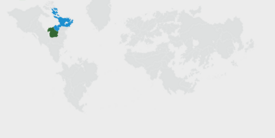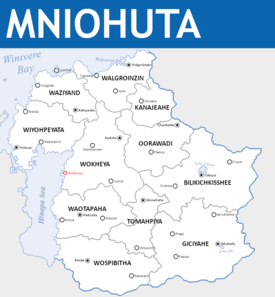Mniohuta
Confederation of Mniohuta ᐅᔭᑌ ᒼᓂᐅᐦᑕ 1 official name
| |||
|---|---|---|---|
| Motto: «ᐁᓬ ᖧᐊᑲ ᓬᔪᑎᔦᑭᔭ, ᐅᐘᐁᐃᓬᐊ᙮» "In great endeavour, union." | |||
| Anthem: ᐅᐩᐊᑌ ᐅᓬᐅᐘᐣ Oyáte Olówaŋ "Song of the Nation" | |||
 Location of Mniohuta on Earth. Members of Hohawin in Blue. | |||
 Political Map of Mniohuta | |||
| Capital | Wokheya | ||
| Largest city | Walgroinzin | ||
| Official languages | Mniyapi | ||
| Recognised regional languages | |||
| Ethnic groups (2020) | [a] | ||
| Religion | List of religions
| ||
| Demonym(s) | Mniohutan Mnohati (plural) | ||
| Government | Parliamentary federated constitutional monarchy | ||
• Premier | Chaska Chimaka | ||
• Chief of the Council | Odakota Akecheta | ||
| Legislature | Conclave of the Confederacy | ||
| Council of Elders | |||
| Council of the People | |||
| Formation | |||
• Event | Around 12,000 BCE | ||
• Founding of Wokheya | 935 BCE | ||
• Asherionic Wars | 1805 | ||
• Articles of Confederation | April 14th, 1822 | ||
• Absorption of the Republic of Waziyand | January 20th, 1836 | ||
• The Spring Constitution | November 3rd, 1865 | ||
| Area | |||
• Total area | 897,115 km2 (346,378 sq mi) | ||
• Water (%) | 5 | ||
| Population | |||
• 2020 census | 29,874,102 | ||
• Density | 30.19/km2 (78.2/sq mi) | ||
| GDP (nominal) | 2020 estimate | ||
• Total | $457,073,760,600 | ||
• Per capita | $15758 | ||
| Gini (2015) | low | ||
| HDI (2015) | very high | ||
| Currency | Mniohutan mazaska (₼) | ||
| Time zone | UTC -5 | ||
| Date format | dd/mm/yyyy | ||
| Driving side | right | ||
| Calling code | +68 | ||
| Internet TLD | .mt | ||
Mniohuta (/mniːoʊhʊtjæ/ muh-nee-O-hu-ta), officially the Confederacy of Mniohuta, is a country in northeastern Norumbia. Its consulates cover a landmass of around 897,115 square kilometers (346,378 square miles), bordered by Elatia to the Northwest across the Hinapa strait, the Hinapa Sea to the West, Winivere Bay to the North, Awasin and Moxaney to the Northeast, Chenes to the West, and Gristol-Serkonos to the South. The majority of the 29,000,000 citizens of Mniohuta live in major cities such as Walgroinzin or in the central plains along the many rivers that snake along the thanzanye plain. Wokheya is the capital of the country while Walgroinzin is the largest and most populous city in the country. Mniohuta is characterised by a largely indigenous population, with a significant Ottonian-Mniohuti creole group, and a handful of other minorities from nearby states.
Various indigenous peoples have inhabited what is now the thanzanye plain since at least 12,000 BCE, remaining largely nomadic until the foundation of what is today Wokheya in 925 BCE by members of the Thituwan tribe and the formation of similar settlements in Mniwa and Oskopa in the following years. Unlike many of its neighbours, the central portion of Mniohuta has never been colonised or settled by a foreign power, with indigenous people living largely undisturbed due to a number of geographic barriers. A handful of Ottonian settlers and fur-trappers made their home on the Northern shore of the country, journeying down from the colony in Wazheganon in search of wealth and open space who formed what is today the consulates of Walgroinzin and Waziyand. While traditionally it was believed that the arrival of the Ottonians was the first contact of indigenous Mniohutans with outsiders, modern historians believe that Haratago nomads and explorers passed through the prairies of central Mniohuta at some point in the 10th or 11th century en route to modern day Elatia and Enyama.
By 1500 BCE, many tribes of the thanzanye plain had organised themselves into proper cooperative city-states which co-existed with a number of still nomadic tribes, both having traditionally tribal governments; though, in the case of the city-states many were beginning to form more complex governments. While conflicts between tribes were not uncommon, evident in the warrior-hunter culture that is still well respected today, the states were also marked by their willingness to compromise and settle disputes in less violent manners such as game-matches and lacrosse (čháŋškopa) tournaments. This largely amicable culture was reflected in willingness to barter and interact, and in limited cases integrate, with the Ottonian settlements along the Northern coast. Despite the growing centralisation of Mniohutan city-states, it was not until the arrival of Asherion in the mid-1800s that the idea of creating a proper nation-state was more thoroughly popularised. Representatives from Mniohuta including the Chief of Wokheya, Spotted Eagle (Gleškáŋblí), would participate as delegates in the Federative Republic of Great Norumbia's short-lived legislature before the republic's collapse. Upon his return to Wokheya, Spotted Eagle called for a meeting of the tribes in what would be called the Eigh Fires Council would be held in which the Articles of Confederation were signed, securing the nation's right to sovereignty at the Congress of Thessalona.
Etymology
The origins of the name Mniohuta stems from the Mniyapi word Mnióhuta (ᒼᓂᐅᐦuᑕ) which roughly translates into english as "Land by the Sea" or "Land of Coasts". Thituwan
Demonyms
A
Official title
B
Geography
A
Climate
ABC
History
Evidence of human habitation in what is now Mniohuta dates back to at least DATE BCE. Archaeological records suggest that
Descriptor
Formation of permanent settlements
Asherionic Wars
Unification of the eight tribes
Democratization and Industrialization
Contemporary History
Government and politics
Premier
Chief of the Council
Mniohuta is a federal, libertarian socialist council republic in the communalist tradition. TEXT TEXT TEXT TEXT.
The Chief of the Council of the House of... premier .
Law
Legal system.
Mniohuta and also description.
Foreign relations
Since the Title and resulting political ...
Military
When the
Constituencies
Description of civil organization and of prefectures(?).
| Commonwealth | Capital | Population | |
|---|---|---|---|
| File:Flag of Walzenia modern.png Mniohuta - Confederacy of Mniohuta | Capital | Population | |
| File:Flag asd.svg Name - Name title | Zorai | 6,201,418 |
Economy
what the.
Agriculture
Energy
Tourism
Transporation
Science and technology
Demographics
With a population of X then Y Template:Largest cities in Mniohuta
Ethnic groups
DESCRIPTION THATS REALLY AWESOME:
- NAME 1: YEAH BABY.
- NAME 2: WHEN WHEN YOU.
Additionally, there are countless immigrant communities which do not fit into any of these groups.
Languages
awesome text.
Religion
Mniohuta time baby..
Education
H.
Health
H.
Culture
1
Architecture
Mnio ysdgjesngewojgweewg.
- Swaglord21 002.jpg
Yeah.
- Wowthatscrazy.jpg
Description.
Cinema
Maybe
Clothing
Swag.
Cuisine
time to talk to hiero.
Holidays
swag day.
Literature
edgar allen ur mom.
Sports
woooo sports ball baby.
- ↑ Since the unification of the eight tribes most of the more minor tribes were absorbed by the larger ethnic groups such as the Thituwan, Hetuwa, Mniwa, or were already fairly closely related.








